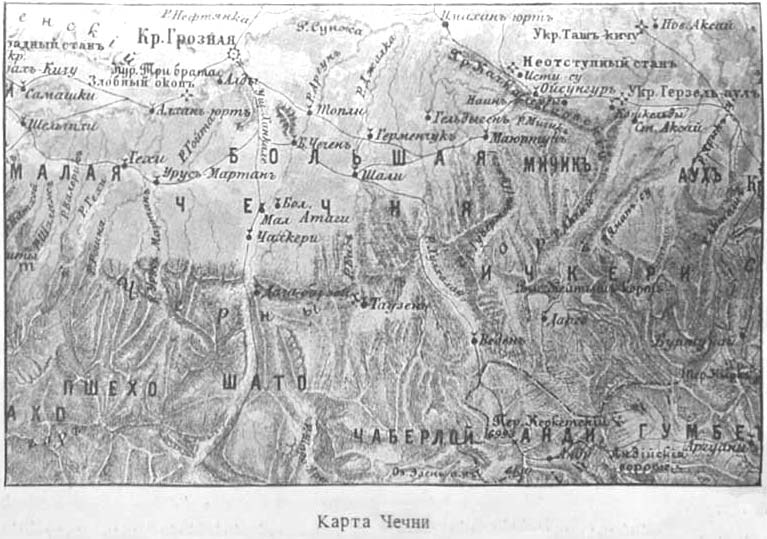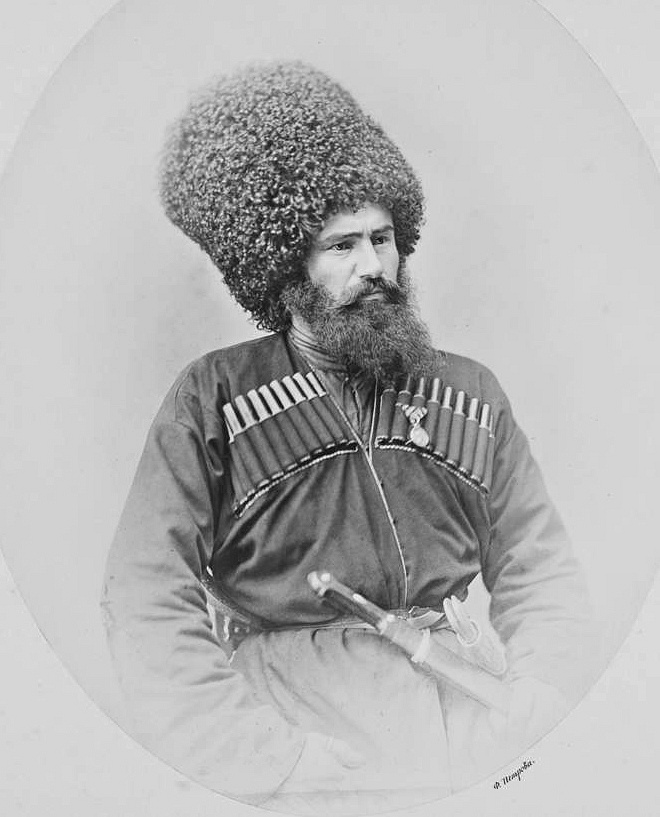|
Aukh
Aukh ( Chechen: Ӏовх, Ӏовха, 'Ovkha, Ӏовхойн мохк; Russian: Ау́х) is a historical region in the current republic of Dagestan, populated by Chechens. Aukh encompasses parts of the Novolak, Khasavyurtovsky Babayurtovsky and Kazbekovsky districts. The Chechens of Dagestan call themselves Aukhs, and speak a sub dialect of the Galanchozh dialect. Historical Inhabitants of Aukh Aukh has historically been inhabited by Chechen tribes and were mentioned by several sources of the time as Okoki, Kachkalyki, Gueni, Michkizi and others. Aukh was given to Dagestan late 1890's. Aukh was very mixed with a lot of different Chechen Teips from all areas of Chechnya and Ingushetia, due to this the tribes living there had several different names in Russian sources. All of them recognized themselves as Nakhchoy (Chechens) as can be attested by a letter from 1756 by the Sala-Uzden prince Adzhi who in his letter calls the Chechen clans living in Dagestan "Nation of Nakhshai" ... [...More Info...] [...Related Items...] OR: [Wikipedia] [Google] [Baidu] |
Aukhs
Aukhs ( ce, Ӏовхой) - ethnographic (subroettic) group of Chechens. Aukhs are currently living in the territories of Novolaksky (former Aukh District), Khasavyurtovsky, Babayurtovsky and Kazbekovsky (Western part of the Aukh) areas of modern central Dagestan, along the rivers Yamansu, Yaryksu, Aktash and Aksai (earlier Eastern Chechnya). Modernity (XXI century) Nowadays, the Aukh District has not yet been restored. The leadership of the Republic of Dagestan conducts some actions to solve the problem of Aukhs, the effectiveness of which is evaluated in different ways. For example, today there is a gradual resettlement of Laks from the Novolaksky district closer to Makhachkala in Novostroy and the return of Aukhs to their former villages. On October 18, 2000, by the Decree of the State Council of the Republic of Dagestan No. 191, the Chechens-Aukhs were attributed to the indigenous peoples of the Republic of Dagestan. Clans (teips) Aukhovsky Society includes the f ... [...More Info...] [...Related Items...] OR: [Wikipedia] [Google] [Baidu] |
Kalininaul, Kazbekovsky District, Republic Of Dagestan
Kalininaul Until 1944 Yurt-Aukh (russian: Калининаул, Until 1944 russian: Юрт-Аух; ce, Ширча-ӀовхМусаев З. М. Чеченский тайп аккой — 2017. — 17 ноября.) is a rural locality (a '' selo'') in Kazbekovsky District of the Republic of Dagestan, Russia, located on the right bank of the Aktas River, at the confluence with the Sala-su River, opposite the ''selo'' of Leninaul, south of Khasavyurt on the border with the Chechen Republic. Population: predominantly Chechen. History The oldest village of Chechens in the Terco-Sulak Meternrech. It was previously known as Shircha-Evla, Yurt-Evla, and Yurt-Aukh. Yurt-Aukh, as it was then called, was until 1944 a part of the Aukh District. In 1944, during the deportation of Chechens to Central Asia, the locals were deported and Avars from the neighboring ''selo'' of Almak settled in their place. In 1956, the Chechens were allowed to return to the Caucasus, but the local auth ... [...More Info...] [...Related Items...] OR: [Wikipedia] [Google] [Baidu] |
Novolaksky District
Novolaksky District (russian: Новола́кский райо́н; Lak: ) is an administrativeLaw #16 and municipalLaw #6 district (raion), one of the forty-one in the Republic of Dagestan, Russia. It is located in the west of the republic and borders with Khasavyurtovsky District in the northeast, Kazbekovsky District in the southeast, and with the Chechen Republic in the west. The area of the district is . Its administrative center is the rural locality (a '' selo'') of Novolakskoye. As of the 2010 Census, the total population of the district was 28,556, with the population of Novolakskoye accounting for 20.8% of that number. History The area of the modern district was historically a part of Aukh, the homeland of the Aukhs Chechens (one of the nine Chechen '' tukkhums''). During the Soviet times, it was incorporated as Aukh District of the Chechen-Ingush ASSR and included the territories of modern Novolaksky District along with parts of Kazbekovsky and Khasavyur ... [...More Info...] [...Related Items...] OR: [Wikipedia] [Google] [Baidu] |
Kumyks
, image = Abdul-Wahab son of Mustafa — a prominent Kumyk architect of the 19th century. , population = near 600,000 , region1 = , pop1 = 503,060 , ref1 = , region2 = , pop2 = 10,000 , ref2 = , region3 = , pop3 = 718 , ref3 = , langs = Kumyk language , region4 = , pop4 = 1200 , ref4 = , region5 = , pop5 = 481 , ref5 = , region6 = , pop6 = 360 , ref6 = , region7 = , pop7 = 33 , ref7 = [...More Info...] [...Related Items...] OR: [Wikipedia] [Google] [Baidu] |
Deportation Of The Chechens And Ingush
The deportation of the Chechens and Ingush ( ce, До́хадар, Махках дахар, inh, Мехках дахар), or Ardakhar Genocide ( ce, Ардахар Махках), and also known as Operation Lentil (russian: Чечевица, Chechevitsa; ce, нохчий а, гӀалгӀай а махкахбахар, Nokhchiy a Ghalghay Makhkakhbakhar, links=no), was the Soviet forced transfer of the whole of the Vainakh ( Chechen and Ingush) populations of the North Caucasus to Central Asia on February 23, 1944, during World War II. The expulsion was ordered by NKVD chief Lavrentiy Beria after approval by Soviet leader Joseph Stalin, as a part of a Soviet forced settlement program and population transfer that affected several million members of ethnic minorities in the Soviet Union between the 1930s and the 1950s. The deportation was prepared from at least October 1943 and 19,000 officers as well as 100,000 NKVD soldiers from all over the USSR participated in this opera ... [...More Info...] [...Related Items...] OR: [Wikipedia] [Google] [Baidu] |
Chechens
The Chechens (; ce, Нохчий, , Old Chechen: Нахчой, ''Naxçoy''), historically also known as ''Kisti'' and ''Durdzuks'', are a Northeast Caucasian ethnic group of the Nakh peoples native to the North Caucasus in Eastern Europe. "Europe" (pp. 68–69); "Asia" (pp. 90–91): "A commonly accepted division between Asia and Europe ... is formed by the Ural Mountains, Ural River, Caspian Sea, Caucasus Mountains, and the Black Sea with its outlets, the Bosporus and Dardanelles." They refer to themselves as Nokhchiy (pronounced ; singular Nokhchi, Nokhcho, Nakhchuo or Nakhtche). The vast majority of Chechens today are Muslims and live in Chechnya, a republic of Russia. The North Caucasus has been invaded numerous times throughout history. Its isolated terrain and the strategic value outsiders have placed on the areas settled by Chechens has contributed much to the Chechen community ethos and helped shape its national character. Chechen society has traditionally been eg ... [...More Info...] [...Related Items...] OR: [Wikipedia] [Google] [Baidu] |
Kazbekovski District
Kazbekovsky District (russian: Казбе́ковский райо́н) is an administrativeLaw #16 and municipalLaw #6 district (raion), one of the forty-one in the Republic of Dagestan, Russia. It is located in the west of the republic. The area of the district is . Its administrative center is the rural locality (a '' selo'') of Dylym. As of the 2010 Census, the total population of the district was 42,752, with the population of Dylym accounting for 20.2% of that number. Geography The district is in rugged terrain in the forested foothills of Degestan, 50 km west of the Caspian Sea. The average height is 500 to 1,000 meters above sea level, with higher elevations reaching 1,900 meters. There are many river valleys, canyons, and gulleys cutting the landscape with fast-moving streams. The largest river, the Aktash River, flows from southeast to northwest through the district. Administrative and municipal status Within the framework of administrative divisions, Kazbek ... [...More Info...] [...Related Items...] OR: [Wikipedia] [Google] [Baidu] |
Avars (Caucasus)
The Avars, also known as ''Maharuls'' ( Avar: , , "mountaineers") are a Northeast Caucasian ethnic group. The Avars are the largest of several ethnic groups living in the Russian republic of Dagestan. The Avars reside in the North Caucasus between the Black Sea and the Caspian Sea. Alongside other ethnic groups in the North Caucasus region, the Avars live in ancient villages located approximately 2,000 m above sea level. The Avar language spoken by the Caucasian Avars belongs to the family of Northeast Caucasian languages. Sunni Islam has been the prevailing religion of the Avars since the 13th century. Ethnonyms According to 19th-century Russian historians, the Avars' neighbors usually referred to them as Tavlins (''tavlintsy''). This is an exonym. Vasily Potto wrote that those to the south usually knew them as Tavlins (''tavlintsy''). Potto wrote, "The words in different languages have the same meaning... fmountain dwellers rhighlanders."''В. А. Потто.'Кавка ... [...More Info...] [...Related Items...] OR: [Wikipedia] [Google] [Baidu] |
Laks (Caucasus)
The Laks (self-designation: Lak) are a Northeast Caucasian ethnic group native to an inland region known as ''Lakia'' within Dagestan in the North Caucasus. They speak the Lak language. Laks historically live in the Lakskiy and Kulinskiy districts of Dagestan. This ethnocultural area is known as Lakia. There are about 200,000 ethnic Laks in the world. Ethnonym The word "Lak" is the self-designation of the Lak people as in Lak expressions: "zhu Lak buru" — we are Lak; "zhu Lakral khalq buru" — we are Lak people; "Laktal" — Laks; "Lakssa" — Lakian, Laks, Lak man; "Lakkuchu" — Lakian man; "Lakku maz" — Lakian language; "Lakkuy" — Lakia; "Lakral kanu" — Lak place; "Lakral kanu" — Lak district; "Lakku bilayat" — Lak country; "Lakral pachchahlug" — Lak state. Laks use the name "Lak" as their ethnonym and placename. P. K. Uslar (1864) reported on the use of self-designation "Lak" by residents of Gazi-Kumukh: "Lakkuchu, Lakkuchunal, nominative plural Lak, genit ... [...More Info...] [...Related Items...] OR: [Wikipedia] [Google] [Baidu] |
Chechen-Ingush Autonomous Soviet Socialist Republic
The Checheno-Ingush Autonomous Soviet Socialist Republic; inh, Нохч-ГӀалгӀай Автономе Советий Социализма Республика, Noxç-Ġalġay Avtonome Sovetiy Socializma Respublika; russian: Чече́но-Ингу́шская Автономная Советская Социалистическая Республика, Checheno-Ingushskaya Avtonomnaya Sovetskaya Sotsialisticheskaya Respublika (Checheno-Ingush ASSR) was an autonomous republics of the Soviet Union, autonomous republic within the Russian Soviet Federative Socialist Republic, in existence from 1936 to 1944 and again from 1957 to 1992. Its capital was Grozny. As of the 1979 census, the territory had an area of and a population of 611,405 being Chechen people, Chechens, 134,744 Ingush people, Ingush, and the rest being Russians and other ethnic groups. History Russian Empire In 1810, the historical Ingushetia voluntarily joined Imperial Russia, and in 1859 the historical Chec ... [...More Info...] [...Related Items...] OR: [Wikipedia] [Google] [Baidu] |



